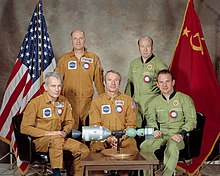Apollo-Soyuz Test Project (1972–75)
 On May 24, 1972, US President Richard M. Nixon and Soviet Premier Alexei Kosygin signed an agreement calling for a joint manned space mission, and declaring intent for all future international manned spacecraft to be capable of docking with each other.[48] This authorized the Apollo-Soyuz Test Project (ASTP), involving the rendezvous and docking in Earth orbit of a surplus Apollo Command/Service Module with a Soyuz spacecraft. The mission took place in July 1975. This was the last US manned space flight until the first orbital flight of the Space Shuttle in April 1981.[49]
On May 24, 1972, US President Richard M. Nixon and Soviet Premier Alexei Kosygin signed an agreement calling for a joint manned space mission, and declaring intent for all future international manned spacecraft to be capable of docking with each other.[48] This authorized the Apollo-Soyuz Test Project (ASTP), involving the rendezvous and docking in Earth orbit of a surplus Apollo Command/Service Module with a Soyuz spacecraft. The mission took place in July 1975. This was the last US manned space flight until the first orbital flight of the Space Shuttle in April 1981.[49]
The mission included both joint and separate scientific experiments, and provided useful engineering experience for future joint US–Russian space flights, such as the Shuttle–Mir Program[50] and the International Space Station.
https://en.wikipedia.org
See this video that is the recreation of the
apollo soyuz
https://www.youtube.com





.jpg)

.jpg/270px-SpaceX_Dragon_v2_Pad_Abort_Vehicle_(16661791299).jpg)
